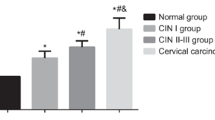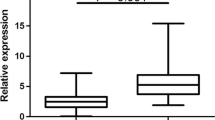Abstract
Advanced stages with distant metastases or recurrence lack reliable prognostic predictor for cervical cancer. Therefore, the purpose of this study was to investigate the clinical significance of miR-335 expression in cervical cancer. A total of 138 cervical cancer samples were collected, and normal cervical tissues were obtained as matched-pair controls. The level of miR-335 expression was examined using quantitative real-time polymerase chain reaction. Overall survival was analyzed using Kaplan–Meier method. Moreover, the relationship between the expression of miR-335 and the clinicopathological features was further analyzed using Cox regression. Lower miR-335 expression was found in cervical cancer specimens. Cervical cancer patients with reduced miR-335 level had shorter survival time, compared with those with high levels of miR-335 expression (P = 0.011, log-rank = 6.458). Through Cox regression, we found that miR-335 expression was associated with the survival of cervical cancer (RR = 0.251, 95 % CI 0.095–0.663, P = 0.005). The results suggested that miR-335 expression was decreased in cervical cancer specimens and lower miR-335 expression resulted in poorer survival in patients with cervical cancer. Our findings indicated that miR-335 may be a candidate factor for predicting prognosis for cervical cancer.



Similar content being viewed by others
References
Ferlay J, Shin HR, Bray F, Forman D, Mathers C, et al. Estimates of worldwide burden of cancer in 2008: GLOBOCAN 2008. Int J Cancer. 2010;127:2893–917.
Wei LH. Prevention and treatment of cervical cancer, it is a long-term and arduous task. Zhonghua Fu Chan Ke Za Zhi. 2013;48:304–6.
Huang EY, Hsu HC, Sun LM, Chanchien CC, Lin H, et al. Prognostic value of pretreatment carcinoembryonic antigen after definitive radiotherapy with or without concurrent chemotherapy for squamous cell carcinoma of the uterine cervix. Int J Radiat Oncol Biol Phys. 2011;81:1105–13.
Tsai CC, Liu YS, Huang EY, Huang SC, Chang HW, et al. Value of preoperative serum CA125 in early-stage adenocarcinoma of the uterine cervix without pelvic lymph node metastasis. Gynecol Oncol. 2006;100:591–5.
Tsai CC, Lin H, Huang EY, Huang SC, Hsieh CH, et al. The role of the preoperative serum carcinoembryonic antigen level in early-stage adenocarcinoma of the uterine cervix. Gynecol Oncol. 2004;94:363–7.
Hacker NF, Nieberg RK, Berek JS, Leuchter RS, Lucas WE, et al. Superficially invasive vulvar cancer with nodal metastases. Gynecol Oncol. 1983;15:65–77.
Pickel H, Haas J, Lahousen M. Prognostic factors in cervical cancer. Eur J Obstet Gynecol Reprod Biol. 1997;71:209–13.
Jin L, Shen Q, Ding S, Jiang W, Jiang L, et al. Immunohistochemical expression of Annexin A2 and S100A proteins in patients with bulky stage IB-IIA cervical cancer treated with neoadjuvant chemotherapy. Gynecol Oncol. 2012;126:140–6.
Li Z, Yu CP, Zhong Y, Liu TJ, Huang QD, et al. Sam68 expression and cytoplasmic localization is correlated with lymph node metastasis as well as prognosis in patients with early-stage cervical cancer. Ann Oncol. 2012;23:638–46.
Song C, Zhu S, Wu C, Kang J. Histone deacetylase (HDAC) 10 suppresses cervical cancer metastasis through inhibition of matrix metalloproteinase (MMP) 2 and 9 expression. J Biol Chem. 2013;288:28021–33.
Esquela-Kerscher A, Slack FJ. Oncomirs—microRNAs with a role in cancer. Nat Rev Cancer. 2006;6:259–69.
Ronchetti D, Lionetti M, Mosca L, Agnelli L, Andronache A, et al. An integrative genomic approach reveals coordinated expression of intronic miR-335, miR-342, and miR-561 with deregulated host genes in multiple myeloma. BMC Med Genomics. 2008;1:37.
Shu M, Zhou Y, Zhu W, Zhang H, Wu S, et al. MicroRNA 335 is required for differentiation of malignant glioma cells induced by activation of cAMP/protein kinase A pathway. Mol Pharmacol. 2012;81:292–8.
Shi L, Jiang D, Sun G, Wan Y, Zhang S, et al. miR-335 promotes cell proliferation by directly targeting Rb1 in meningiomas. J Neuro-Oncol. 2012;110:155–62.
Huang HY, Cheng YY, Liao WC, Tien YW, Yang CH, et al. SOX4 transcriptionally regulates multiple SEMA3/plexin family members and promotes tumor growth in pancreatic cancer. PLoS One. 2012;7:e48637.
Heyn H, Engelmann M, Schreek S, Ahrens P, Lehmann U, et al. MicroRNA miR-335 is crucial for the BRCA1 regulatory cascade in breast cancer development. Int J Cancer. 2011;129:2797–806.
Dohi O, Yasui K, Gen Y, Takada H, Endo M, et al. Epigenetic silencing of miR-335 and its host gene MEST in hepatocellular carcinoma. Int J Oncol. 2013;42:411–8.
Cao J, Cai J, Huang D, Han Q, Chen Y, et al. miR-335 represents an independent prognostic marker in epithelial ovarian cancer. Am J Clin Pathol. 2014;141:437–42.
Yan Z, Xiong Y, Xu W, Gao J, Cheng Y, et al. Identification of hsa-miR-335 as a prognostic signature in gastric cancer. PLoS One. 2012;7:e40037.
Xu Y, Zhao F, Wang Z, Song Y, Luo Y, et al. MicroRNA-335 acts as a metastasis suppressor in gastric cancer by targeting Bcl-w and specificity protein 1. Oncogene. 2012;31:1398–407.
Esteller M. Non-coding RNAs in human disease. Nat Rev Genet. 2011;12:861–74.
Jiang W, Chen X, Liao M, Li W, Lian B, et al. Identification of links between small molecules and miRNAs in human cancers based on transcriptional responses. Sci Rep. 2012;2:282.
He L, Hannon GJ. MicroRNAs: small RNAs with a big role in gene regulation. Nat Rev Genet. 2004;5:522–31.
Babashah S, Soleimani M. The oncogenic and tumour suppressive roles of microRNAs in cancer and apoptosis. Eur J Cancer. 2011;47:1127–37.
Christensen BC, Moyer BJ, Avissar M, Ouellet LG, Plaza SL, et al. A let-7 microRNA-binding site polymorphism in the KRAS 3’ UTR is associated with reduced survival in oral cancers. Carcinogenesis. 2009;30:1003–7.
Slaby O, Svoboda M, Fabian P, Smerdova T, Knoflickova D, et al. Altered expression of miR-21, miR-31, miR-143 and miR-145 is related to clinicopathologic features of colorectal cancer. Oncology. 2007;72:397–402.
Yanaihara N, Caplen N, Bowman E, Seike M, Kumamoto K, et al. Unique microRNA molecular profiles in lung cancer diagnosis and prognosis. Cancer Cell. 2006;9:189–98.
Peng HH, Zhang YD, Gong LS, Liu WD, Zhang Y. Increased expression of microRNA-335 predicts a favorable prognosis in primary gallbladder carcinoma. Onco Targets Ther. 2013;6:1625–30.
Ma J, Li N, Guarnera M, Jiang F. Quantification of plasma miRNAs by digital PCR for cancer diagnosis. Biomark Insights. 2013;8:127–36.
Yang H, Zhang C, Lu YX, Wu XJ, Yuan L, et al. Construction of has-miR-335 lentiviral vector and verification of the target gene of miR-335. Nan Fang Yi Ke Da Xue Xue Bao. 2012;32:306–11.
Tome M, Lopez-Romero P, Albo C, Sepulveda JC, Fernandez-Gutierrez B, et al. miR-335 orchestrates cell proliferation, migration and differentiation in human mesenchymal stem cells. Cell Death Differ. 2011;18:985–95.
Lynch J, Fay J, Meehan M, Bryan K, Watters KM, et al. MiRNA-335 suppresses neuroblastoma cell invasiveness by direct targeting of multiple genes from the non-canonical TGF-beta signalling pathway. Carcinogenesis. 2012;33:976–85.
Jiang J, Sun X, Wang W, Jin X, Bo X, et al. Tumor microRNA-335 expression is associated with poor prognosis in human glioma. Med Oncol. 2012;29:3472–7.
Conflicts of interest
None
Funds
None.
Author information
Authors and Affiliations
Corresponding author
Rights and permissions
About this article
Cite this article
Wang, C., Jiang, T. MicroRNA-335 represents an independent prognostic marker in cervical cancer. Tumor Biol. 36, 5825–5830 (2015). https://doi.org/10.1007/s13277-015-3252-2
Received:
Accepted:
Published:
Issue Date:
DOI: https://doi.org/10.1007/s13277-015-3252-2




